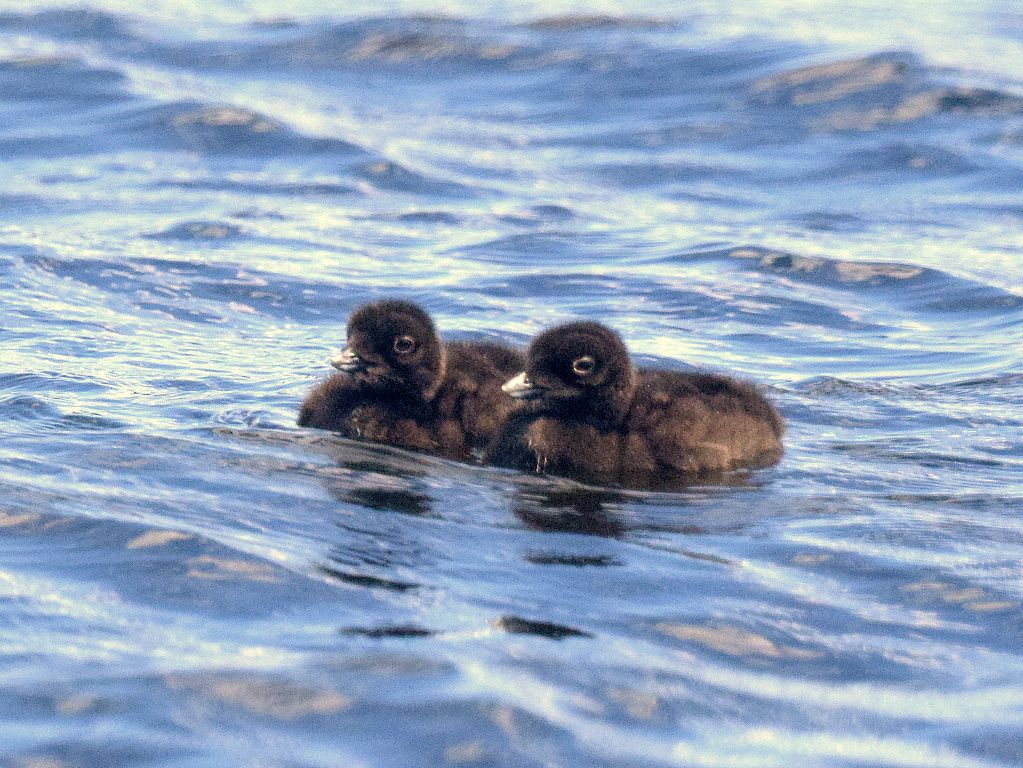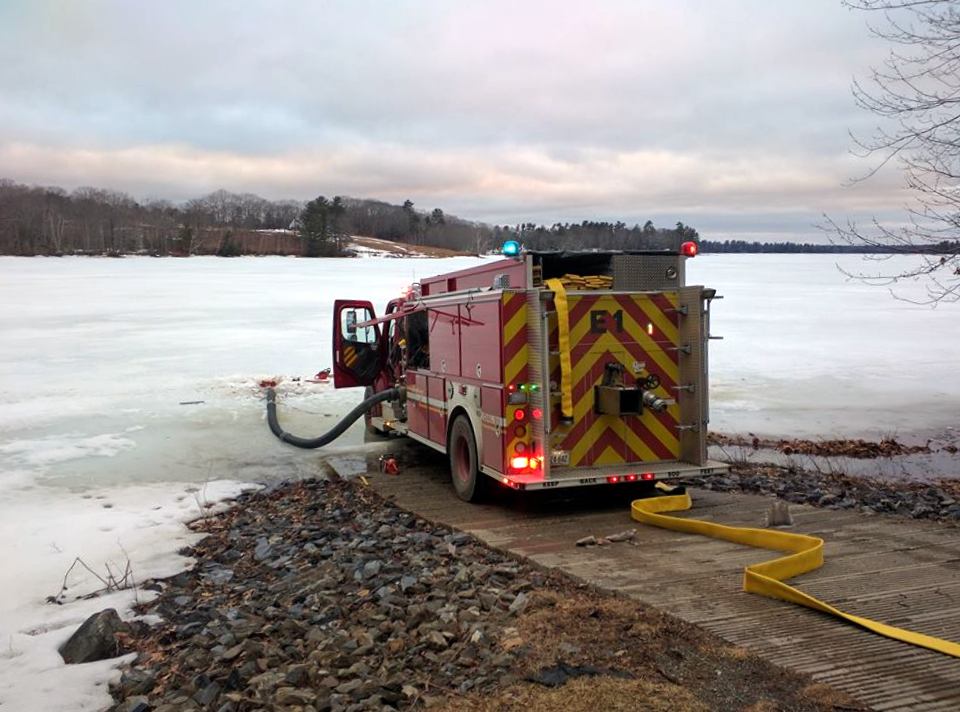Well it turns out the loons had two chicks this year, not one as I originally thought. I went out this evening to get some pictures, and the loons cooperated happily. Even when I knew there were two I could often only see one. Having two loon babies is good because it increases the chances of one of them surviving to adulthood. On the downside, one almost always fails to thrive…
Category Archives: Wildlife
24 June 2018: Loons Have a Baby! [UPDATED]
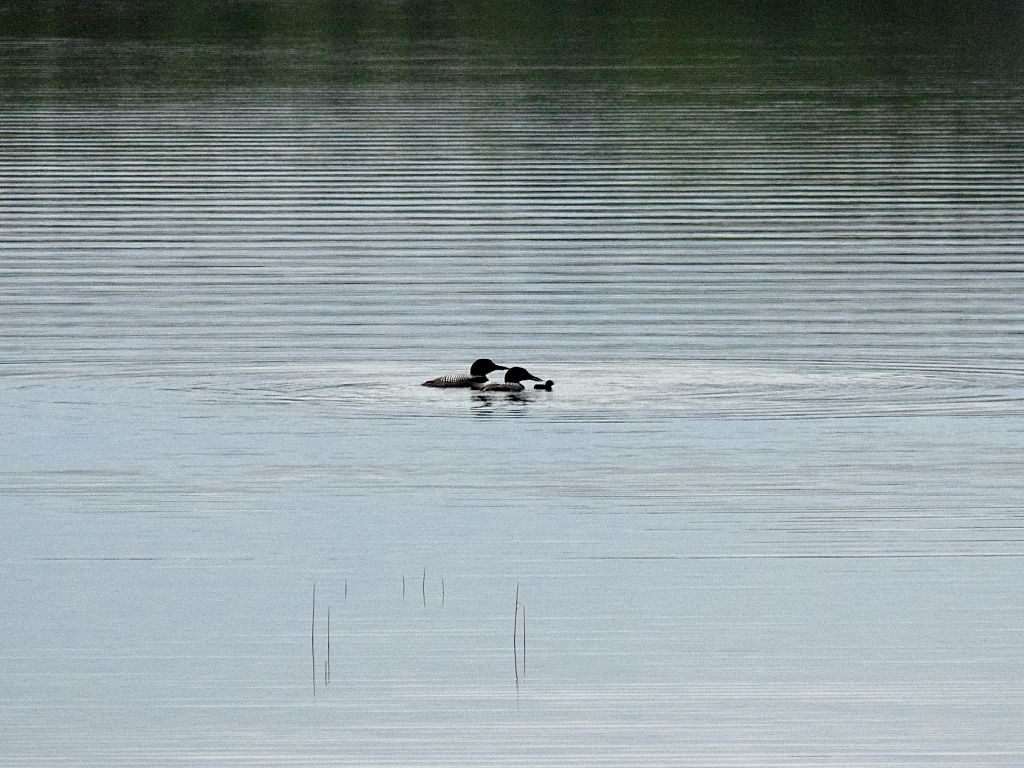 For the second year in a row, our resident loon family has successfully hatched a baby loon. Just one this year rather than the usual 2. I noticed one parent or the other hanging around the nest area today and saw one loon, presumably the male, chasing another loon around in a classic loon “get out and stay out” territorial battle, and suspected that hatching was near. Please give them a wide berth.
For the second year in a row, our resident loon family has successfully hatched a baby loon. Just one this year rather than the usual 2. I noticed one parent or the other hanging around the nest area today and saw one loon, presumably the male, chasing another loon around in a classic loon “get out and stay out” territorial battle, and suspected that hatching was near. Please give them a wide berth.
[27 June UPDATE]: We have 2 loon babies! No idea how the second baby escaped notice this long, but it did. No pictures yet, but I clearly saw two babies when over visiting our Treasurer this morning.
12 June 2018: Loon Nest Update
The loons are still sitting on their nest and while it’s sitting rather high out of the water, I think it’s still surrounded by water which is important for keeping predators away from the nest. The lake has fallen almost 5″ since I discovered the nest on May 31st. If the water falls too much or recedes too far from the nest, they’ll have to abandon it. For what it’s worth, the lake which just hit -48″ below the normal high water mark is now only falling about 1/4″ per day and any rain we receive will help slow the fall further. The biggest threat from fluctuating water levels is flooding and with yet another drought setting in, I don’t see flooding as a big risk this year.
I’m not sure when the loons laid their eggs so I don’t know when they’ll hatch but seeing as how they were sitting on May 31, barring complications the eggs should hatch around the last week of June. Gestation is around 27 days and can often stretch to 30. Fingers crossed.
I have not had a chance to get the Loon Nesting signs out but will try to get to it later this week. In the meantime, please avoid the marsh on the southwest corner of the lake by Route 126.
31 May 2018: Loon Family Nesting again on Clary Lake
Margaret and I spotted this year’s loon nest yesterday evening, it’s located over on the southwest corner of Clary Lake not far from Route 126. I haven’t checked yet, but it’s undoubtedly visible from the road. This is the same place they tried to nest back in 2012, a nesting effort that failed when heavy rains caused the lake level to rise, flooding the nest (pictures in the Summer 2012 photo gallery). That year the loons attempted to nest a second time over on the north shore in the more traditional location (See News from 2012) but a falling water level resulted in that nest being abandoned as well. The loons didn’t even try to nest again until the summer of 2016.
Please give the nest a wide berth as much as possible. We’ll put the Loon Nesting signs out shortly, and I’ll try and get some better pictures.
14 December 2017: Oops! That Goose is a Swan! [UPDATED]
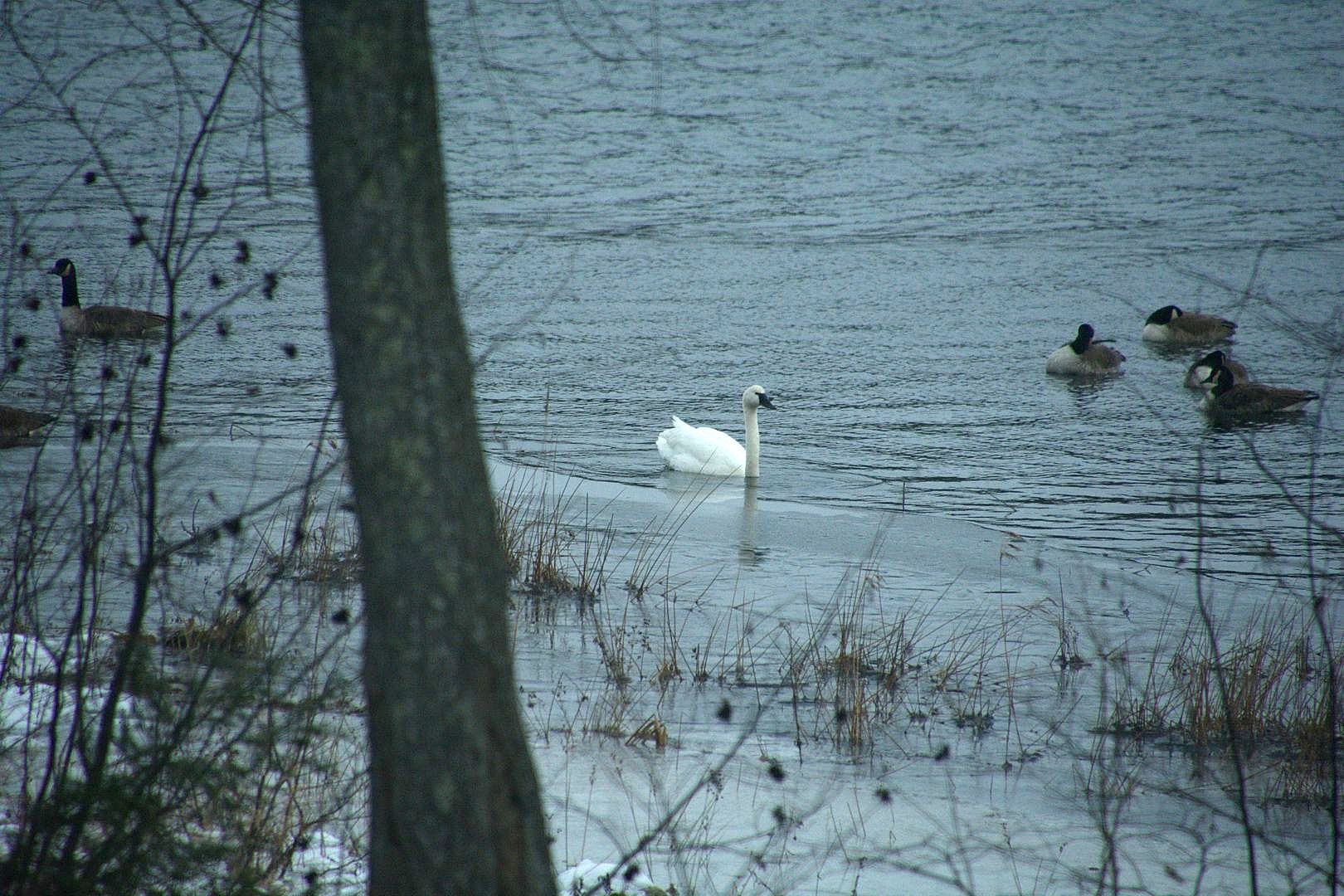 Woah. Epic fail on my part: that so-called “domestic goose” I posted about last week appears based on photographs David Hodsdon sent me today to be a Trumpeter or perhaps a Tundra Swan (though still awaiting definitive determination by experts). In my own defense, all I had to work with were a couple of pictures that I took at long-distance showing the back of the Swan. I didn’t get a good side or front view. There are only 3 species of Swan in North America (Trumpeter, Tundra, and Mute) and Maine is not known to be within the range of any of them. Frankly it looks to me like a Trumpeter Swan, but IF&W Wildlife Biologist Keel Kemper took one look at the above picture and believes it is a Tundra Swan, rarely if ever seen in Maine.
Woah. Epic fail on my part: that so-called “domestic goose” I posted about last week appears based on photographs David Hodsdon sent me today to be a Trumpeter or perhaps a Tundra Swan (though still awaiting definitive determination by experts). In my own defense, all I had to work with were a couple of pictures that I took at long-distance showing the back of the Swan. I didn’t get a good side or front view. There are only 3 species of Swan in North America (Trumpeter, Tundra, and Mute) and Maine is not known to be within the range of any of them. Frankly it looks to me like a Trumpeter Swan, but IF&W Wildlife Biologist Keel Kemper took one look at the above picture and believes it is a Tundra Swan, rarely if ever seen in Maine.
I’ve got some Maine birders looking into this and will post an update when available.
[UPDATE]: The expert birders have reached a consensus: Tundra Swan. According to this Cornell University site, these birds spend their summers mating along the northernmost fringes the Arctic Tundra of Canada and Alaska and only migrate south into the United States Maine in Winter. Maine is not generally considered part of the Tundra Swan’s migratory range. How exciting to have spotted this bird on Clary Lake!
05 December 2017: Anyone Missing a Goose?
There’s been a white domestic goose hanging out on Clary Lake with some Canada Geese this fall. For a domestic goose it was quite shy, it wouldn’t face me at all but started swimming away from me as soon as it saw me whereas the Canada Geese were totally unconcerned. This picture (and one other in the Fall 2017 gallery) was taken a couple of weeks ago, but David Knight told me earlier today that he saw it earlier today down at his end of the lake, again, hanging out with a flock of Canada Geese. In any case, I doubt it can fly so when the lake finally freezes over, it will either get frozen in the ice or make it to shore where it becomes easy prey for a fox or raccoon. I know the folks that bought the old MacDonald place have some geese, it may be one of theirs. I’ve emailed them to see if they’re missing a goose…
Speaking of pictures, I’ve been rather uncharacteristically busy this fall and have a pile of pictures to process and post including some of damage from last month’s wind storm. I’ll get around to it when winter settles in and I have more time. If you have any pictures of downed trees and property damage from that storm, send them to me and eventually I’ll find the time to post them.
Everything you ever wanted to know about Sea Lamprey!
Unfortunately I have another engagement Monday night or I’d be going to this presentation. It sounds fascinating:
|
|
|
Come learn about Sea Lamprey
with expert Lee Margolin
|
|
|
Sea Lamprey expert Lee Margolin will be presenting about Sea Lamprey and taking questions at a public meeting on Monday, December 4 from 6-8pm at the Sheepscot Lake Fish & Game Club in Palermo. This is the first of what will be several opportunities to learn about Maine’s native sea-run fish species.
Lee has a PhD in Biology with research focused specifically on Sea Lamprey and over 25 years of experience with the species. Anyone curious to learn more about Sea Lamprey or their impact on other fish species and ecosystems is encouraged to attend.
The Fish & Game Club is located at 19 Leeman Arm Rd, Palermo, just off of Route 3 next to the boat launch. Please direct any questions to Garrison Beck, Midcoast Conservancy Director of Water Conservation, 207-389-5157 or garrison@midcoastconservancy.
We hope to see you there!
|
|
13 October 2017: Loon Baby Update
The 2017 fledgling loon, now about 14 weeks old, is pretty much on its own and is rarely seen with it’s parents anymore. It is about full size but it doesn’t have full adult plumage yet so is easy to identify. I spotted it this morning while David Hodsdon and I were out for our last water monitoring session of the season, and was able to get close enough to get this picture. It was a little leery of us and wouldn’t let me get any closer. In the next few weeks it will be flapping around the lake, strengthening it’s wings before it takes off and heads for the coast.
09 October 2017: The Beavers Are Back
The water level of Clary Lake has effectively bottomed out this fall about a foot higher than it did last fall. I know the outflow rate has been slowed down considerably as a result of thick vegetation in the outlet channel, but that still didn’t explain why the lake hasn’t fallen as low as expected. Today I discovered why: beavers have begun to block the channel at the downstream end of the Narrow Gauge Railroad abutment located at the head of the mill pond (picture at left). The small dam is only about one foot tall but it is already holding back Clary Lake.
Sadly, I don’t think the beaver responsible for this new dam are going to get a chance to build it much higher: beaver trapping season in this area starts October 29th, and this morning I saw Richard Smith, owner of Aquafortis Associates LLC standing on his side of the Narrow Gauge Railroad abutment talking with someone who looked like (and drove the same red Ford pickup truck as) the person they hired last March to trap out the beaver that had been working to plug up the outlet gate last winter. At least he was driving the same red Ford pickup truck.
While up at the narrow gauge abutment looking at the new beaver dam, I happened to notice that Kelley and Smith have put a tarp over one side roof of the red building (at left) and fastened it down with battens. Nice to see them maintaining their property.
Finally, as I was walking back to my car, I noticed that the gate which has normally been obscured by weeds was fully visible, so I took a picture of it (at left). I’ve known all along that the 34″ diameter gate was partially obstructed, but I always thought is was blocked by a log or rocks or something. However, the picture clearly shows that the gate was built that way: the ‘obstruction” is actually made of steel and completely blocks the bottom third of the gate.
These pictures have been added to the Fall 2017 Photo Gallery.
07 August 2017: Loon Family Update
The baby loon is growing quickly. It is diving now. It’s stomach feathers are white. Pretty soon we’ll see it flapping across the water, exercising it’s wings in preparation for flying this fall. I’ve gotten quite close to it a few times when I was out fishing, but I didn’t have my camera with me. I shot this picture as the youngster and a parent swam past my shoreline the other day.
And Then There Was One: Loon Family Update
Arolyn Antognoni used to call the southwest corner of Clary Lake the “l0on nursery” as the loons seemed to hang out in this area a lot with their newly hatched chicks. For whatever reason once the loon chicks arrive, the loon family does in deed seem to spend a lot of time in this area. This includes the cove on the west shore by Ron Rollins property south around what we used to call the “Erskine Swamp” and along the Fergusson property over to Ward’s Point. Yesterday they spent the morning hanging out right off my shoreline, at times approaching within less than 50′ of where I had my camera set up and their antics feeding the babies afforded me some wonderful opportunities to record their behavior.
I’m a little (OK, a lot) late on this loon update. I started it back on the 4th of July when we had 2 loon chicks (above). By the next day we were down to one: it appears as has happened in the past, one loon chick out-competes the other for food and attention and ends up being killed by the more dominant chick, while the parents look on. Harsh yes, but the chances of the survival of the remaining chick are greatly increased. It doesn’t always happen, but if often does.
 Last Saturday was the annual Audubon Loon Count which takes place from 7:00 AM to 7:30 AM on the third Saturday in July. Mary Gingrow-Shaw and her husband Ernie went counter clockwise around the lake in their boat while I in mine, accompanied by my wife Margaret, went the other direction. 4 loons in all were sighted including the one loon chick (picture at left) Both parents were down in the southwest end of the lake and a lone adult loon was spotted off of Hodsdon Lane, not too far from the State boat launch.
Last Saturday was the annual Audubon Loon Count which takes place from 7:00 AM to 7:30 AM on the third Saturday in July. Mary Gingrow-Shaw and her husband Ernie went counter clockwise around the lake in their boat while I in mine, accompanied by my wife Margaret, went the other direction. 4 loons in all were sighted including the one loon chick (picture at left) Both parents were down in the southwest end of the lake and a lone adult loon was spotted off of Hodsdon Lane, not too far from the State boat launch.
The next morning Tom Vigue called to tell me that a dead adult loon had washed up on his shoreline. He said he’d drop it off later, which he did. It is now in my freezer waiting pickup by an IF&W Wildlife Biologist. It will be sent off to Tufts University which has an ongoing loon mortality project (http://www.tufts.edu/vet/
That’s all for now.

30 June 2017 Video: Baby Loons on Clary Lake
29 June 2017: We have Baby Loons on Clary Lake!
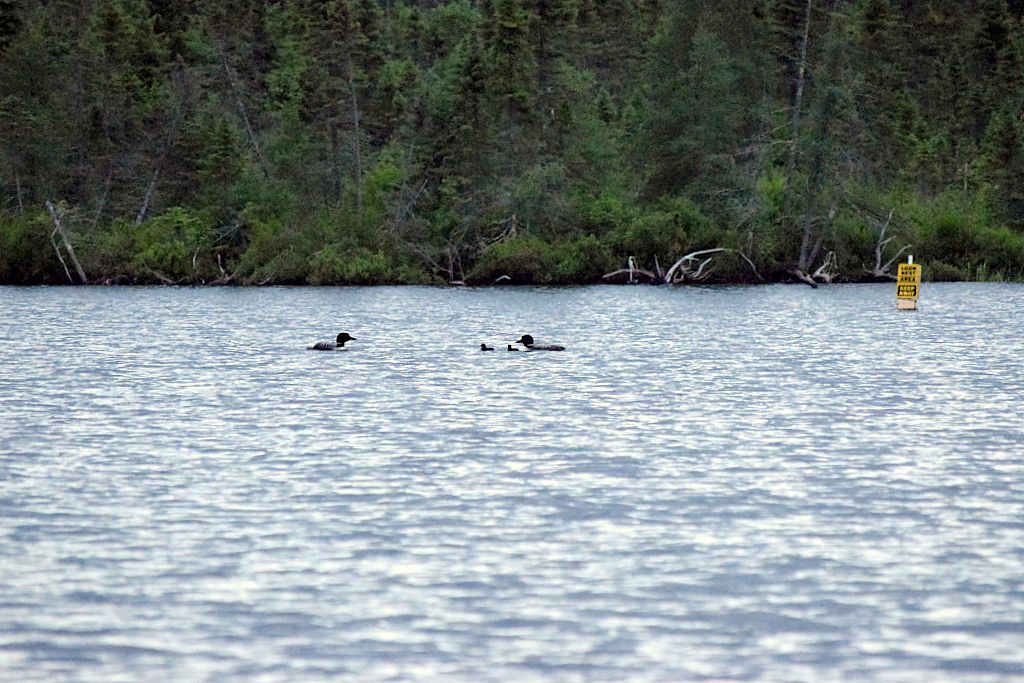 We have baby loons on Clary Lake! For the first time since 2008 our resident Loon family has successfully nested, despite a falling water level that has threatened to strand the nest too far from the water. Yesterday afternoon there was a loon sitting on the nest, so the eggs must have hatched sometime today. I first spotted the nest back on June 7th and I estimated at that time that the eggs had been laid on or about May 31st. That date turned out to be right on the money. Fortunately, and no thanks to the dam owner who left the dam gate wide open all month, the lake level has not fallen as fast as expected, having dropped only about 11″ (0.36″ per day) since the nest was started. Given the lack of rain in June and with the dam’s gate wide open, I expected the lake to have dropped twice as much or about 3/4″ per day. I’m still struggling to explain that discrepancy. Continue reading
We have baby loons on Clary Lake! For the first time since 2008 our resident Loon family has successfully nested, despite a falling water level that has threatened to strand the nest too far from the water. Yesterday afternoon there was a loon sitting on the nest, so the eggs must have hatched sometime today. I first spotted the nest back on June 7th and I estimated at that time that the eggs had been laid on or about May 31st. That date turned out to be right on the money. Fortunately, and no thanks to the dam owner who left the dam gate wide open all month, the lake level has not fallen as fast as expected, having dropped only about 11″ (0.36″ per day) since the nest was started. Given the lack of rain in June and with the dam’s gate wide open, I expected the lake to have dropped twice as much or about 3/4″ per day. I’m still struggling to explain that discrepancy. Continue reading
25 June 2017: Nesting Loon Update
I’ve been meaning to post an update on our nesting loons for more than a week, but I’ve been a little busy! As of this morning there was a loon sitting on the nest. I first spotted the nest 19 days ago, on June 6th but it is likely that nesting had been underway for about a week earlier. This would make the eggs 25-26 days old. The gestation period for loon eggs is 28 to 30 days so with luck they’ll hatch in 3-5 days. The nest is abandoned shortly after the chicks hatch.
The lake level has fallen 10″ or more since the nest was started. The net effect of this drop in lake level has been to increase the distance between the nest and the water. If the distance to the water becomes too great, they’ll abandon the nest however it doesn’t look like that’s going to happen this time. I’ve got my fingers crossed.
The last time a loon family successfully nested on Clary Lake was in 2008.
07 June 2017: Loon Nest Spotted on Clary Lake
The Loons are once again trying to nest on Clary Lake. This year’s nest is located in more or less the traditional loon nesting location, in the cove over by the floating bog on the north shore, just east of the outlet. The loons haven’t faired too well in recent years and I truly hope they succeed this time around. The last time they successfully hatched some eggs was back in 2008. We’ve documented numerous failed nesting attempts since then, and severe variations in water level has been the primary cause of nest failure. Last year, their eggs turned out not to be fertile.
Typically the male and female loons build the nest together over the course of a about week in late May or early June and lay eggs shortly thereafter. Gestation is 28 to 30 days. Since they can only walk on land with great difficulty, they try to build their nest just a few inches above the water surface to facilitate getting on an off it. I don’t know when they started sitting on this latest nest, but it appears to be a good 8″ to 10″ above the water surface indicating the lake may have already fallen as much as 5″ or 6″ since being built. Therefore I’d guestimate they started sitting on the nest around the 1st of June, give or take a few days. With a lot of luck, we might see babies somewhere around the end of June. This however depends on the lake level staying relatively stable for the rest of this month. It is currently falling about 3/4″ per day, and it won’t take long to strand the nest at that rate.
The lake level is currently -38″ below the high water mark and falling. I challenge Mr. Kelley to shut the dam’s gate to maintain the current water level for the next month to give the nesting loons a chance to raise a family. Continue reading
18 April 2017: Spring Musings and a Look Ahead
[dropcap]I[/dropcap] try to keep this news forum factual and informative and not all that speculative. From time to time however I am compelled to offer up some commentary on what has been happening, where we are and where it looks like we are headed. This is one of those times. My goal is to bring some perspective and commonality into our lives where they intersect with Clary Lake and the travails that have assaulted it for so long. Spring is a good time for this kind of musing: it’s a time to wake up, gear up, get in shape, and get ready for another season. I feel this is going to be an important year, that a lot is going to happen. We may not see a resolution of our water level crisis this year but then again we might, the problem being that I really have no idea what a “resolution” might look like. Certainly we’ll see some real progress towards a resolution. Not only am I prepared to be surprised, I expect to be. If one thing has been proven time and time again it is that we have no idea what lies around the next corner. Continue reading
Clary Lake: A Year In Pictures
A little over a year ago I got this idea of assembling a year’s worth of webcam pictures into a video. Our webcams take a picture every two minutes from 4:00 AM until 10:00 PM and upload them to the server, so I simply modified the script that manages the webcam photos so as to archive all pictures taken at the top of the hour (i.e., 4:00, 5:00, 6:00, etc) in a separate directory for safe keeping. Then I forgot about it. Then a couple of days ago, I remembered it!
So here is the video. It covers 365 days from March 9, 2016 through March 9, 2017. There are a few days missing (including 3-13-16 through 3-15-16 which coincided with ice out last spring for some reason, and a couple of other days in the fall). I also decided to delete all the night-time photos, ending up with 4,651 pictures covering Clary Lake in all its glory, compiled into a video at a frame rate of 10/second. It is 7:45 long. Best viewed full screen with the sound on:
10 December 2016: Avian Haven’s Bird Pictures of 2016
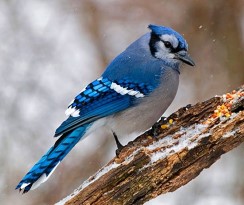 The Good Folks at Avian Haven have issued their Favorite Bird Pictures from 2016→. Check it out!
The Good Folks at Avian Haven have issued their Favorite Bird Pictures from 2016→. Check it out!
Avian Haven is a non-profit organization founded in Freedom, Maine as a wild bird rehabilitation center dedicated to the return of injured and orphaned wild birds of all species to natural roles in the wild. They have a great site and do good work.
21 July 2016 Loon Update: Eggs Not Viable, Nest Abandoned
Yesterday afternoon I stopped to check on the loon nest and found it abandoned, with no evidence of any eggs. There was a loon floating nearby but it wasn’t fishing or tending babies, it was just sitting. Randy Wing was with me and he told me that he’d seen eggs in the nest the day before. I too had seen a loon sitting on the nest that day. I decided to check back in the morning. This morning I checked the nest and it was still abandoned with no loons in sight so I grabbed my camera walked around the edge of the cove to look for the nest. I found it without difficulty (picture, at left). I was surprised to see how far the water line had receded from where it was when we first started watching it, 30+ days ago. When first spotted, the water was right up to the edge of the nest and we were concerned about the possibility of flooding; this morning it was a good 6′ away from it- not obvious from our vantage point on shore due to foreshortening. Flooding turned out to not be a problem. Continue reading
18 July 2016: Unusual Summer Bird Sightings on Clary Lake

An immature Glossy Ibis spotted poking around on the shore of Clary Lake. Definitely an unusal breed of bird for these parts. Photograph by George Fergusson 13 July 2016
It’s been a good summer for rare and unique bird sightings on Clary Lake. First, back on July 13th I was on my way home from an afternoon fishing when I spotted a relatively large black wading bird poking around on the shoreline over on the Relyea property next to the Antognoni home. The light was fading and it was a little challenging taking pictures with good definition, but I got a few. I’d never seen a bird like it and was unable to identify the bird, so I sent a few pictures off to some birder contacts of mine and they quickly identified it as an immature Glossy Ibis. I’ve never seen an adult one let alone an immature one. They are known to nest as far north as Southern Maine but occasionally venture further north.
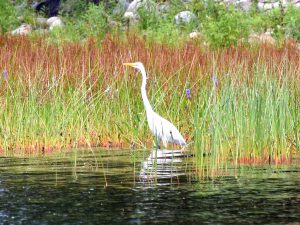
Great Egret, Clary Lake. What a graceful bird! Not unheard of around here, but definitely an unusual sighting. I’ve only seen a Great Egret one other time on Clary Lake. Photograph by George Fergusson 17 July 2016
Then yesterday afternoon I was out fishing over on the north shore when I spotted a Great Egret standing in the shallows. In all my years on Clary Lake I’ve only seen a Great Ibis one other time. They’re rare but not unheard of around here.
I checked this morning and one of the loons was sitting on the nest but there is still no sign of the loon eggs hatching, and I’m concerned that the eggs may not be viable. While the nest was first spotted around June 12th, we’re not certain when the eggs were actually laid. Looking back at my log, I first obtained photographs of the loon eggs on June 24th which was 25 days ago, though it is likely the eggs were laid sometime before that. In any case, as long as the loons are sitting on them, I’ll hold out hope they’ll hatch.
I’ve posted a few more pictures of these birds in the Spring/Summer 2016 photo gallery.










